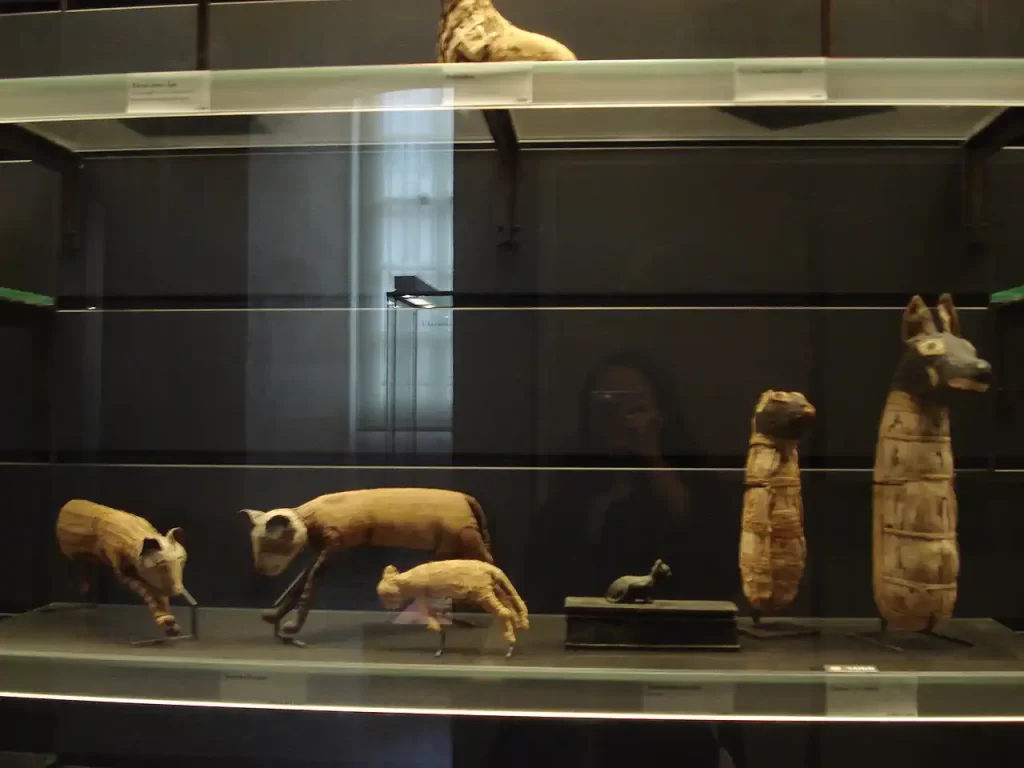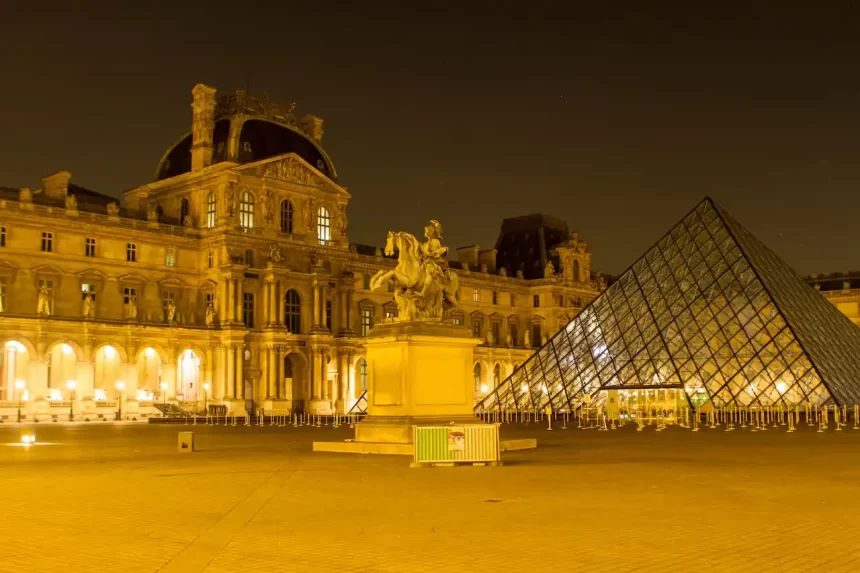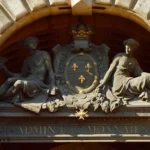The Louvre Museum in Paris
The Louvre Museum in Paris, renowned for its extraordinary collection of art and historical artifacts, stands as one of the world’s largest and most visited museums. Housed in the Louvre Palace, a former royal residence, the museum boasts an impressive façade and iconic glass pyramid entrance, blending historic architecture with modern design. It spans an extensive area, offering a diverse array of exhibits that range from ancient civilizations to 19th-century European art. The museum’s collection is divided into eight departments, including Near Eastern Antiquities, Egyptian Antiquities, Greek, Etruscan, and Roman Antiquities, Islamic Art, Sculptures, Decorative Arts, Paintings, and Prints and Drawings, each showcasing an array of significant works.
Among its most celebrated pieces are Leonardo da Vinci’s “Mona Lisa,” the “Venus de Milo,” and the “Winged Victory of Samothrace.” These masterpieces, along with thousands of other works, draw millions of visitors annually. The Louvre’s collection spans over 7,500 years of history and includes over 380,000 objects, with about 35,000 works on display in an exhibition space of 60,600 square meters. The museum’s curation and presentation of art and artifacts provide a comprehensive overview of human creativity and history, making it a treasure trove for art lovers, historians, and casual visitors alike.
In addition to its permanent collection, the Louvre also hosts temporary exhibitions, lectures, and educational programs, contributing to its role as a cultural epicenter in Paris. The museum’s influence extends beyond its walls through its active participation in cultural and artistic exchanges worldwide. The Louvre Museum not only serves as a guardian of the past but also as a promoter of cultural understanding, continually adapting to the evolving world of art and history. Its status as a symbol of French culture and history makes it a must-visit destination for those traveling to Paris.
Top Attractions For Visitors
Mona Lisa
The Mona Lisa, painted by Leonardo da Vinci, is arguably the most famous artwork in the Louvre. This masterpiece is known for its mysterious smile and the enigmatic gaze that follows you around the room. When visiting, you’ll find it in the Denon wing of the museum, well-protected and often surrounded by a crowd of admirers.

Despite the crowd, take your time to appreciate the painting’s subtle details and the mastery of da Vinci’s technique. The Mona Lisa’s fame lies not just in its artistic beauty but also in its intriguing history, involving theft and centuries of speculation about the identity of the woman portrayed.
To make the most of your visit, consider coming early or during off-peak hours. This way, you’ll have a better chance of viewing the painting with fewer distractions. Don’t forget to explore the surrounding galleries too, which house an impressive collection of Renaissance art, adding context to this iconic piece.
Venus de Milo
The Venus de Milo is a celebrated ancient Greek statue, renowned for its missing arms, which only add to its allure. Found in the Louvre’s Sully wing, this sculpture is a stunning example of Hellenistic art. Its graceful lines and detailed drapery showcase the extraordinary skill of ancient sculptors.

The mystery of her missing arms has intrigued visitors for years. While there are many theories, the true story behind their disappearance remains unknown. This enigma adds to the charm of the Venus de Milo, making her a must-see for anyone interested in ancient art.
Around the Venus de Milo, you’ll find a wealth of other Greek, Etruscan, and Roman artworks. This section of the museum is a treasure trove for those interested in ancient civilizations. Take your time to wander through the halls and discover more stunning pieces that narrate stories from centuries ago.
Winged Victory of Samothrace
The Winged Victory of Samothrace, also known as the Nike of Samothrace, is an awe-inspiring Hellenistic sculpture that stands proudly at the head of the Daru staircase. This sculpture is celebrated for its dynamic form and the impression of movement it conveys. The way the goddess Nike seems to be alighting on the prow of a ship is a stunning display of artistry.
The sculpture’s intricate details, especially in the wings and the beautifully rendered folds of her garment, appear to ripple as if caught in a sea breeze. It’s this lifelike quality that makes the Winged Victory a captivating sight.
As you stand there, take a moment to appreciate the craftsmanship and the sense of triumph that this sculpture exudes. It’s not just a piece of stone; it’s a timeless symbol of victory and beauty, capturing an eternal moment of triumph in a way that few other artworks can.
Egyptian Antiquities
The Egyptian Antiquities department in the Louvre is a journey back in time to one of the world’s most fascinating ancient civilizations. Here, you’ll find a vast collection that includes mummies, statues, jewelry, and the famous Seated Scribe. The attention to detail in these artifacts provides incredible insight into the daily life, religion, and culture of ancient Egypt.

Notable among the collection is the Great Sphinx of Tanis, an imposing and mysterious statue that represents the pharaoh as a protective deity. The sphinx, with its lion’s body and human head, symbolizes power and wisdom, key elements in Egyptian belief.
As you wander through the Egyptian galleries, you’ll be amazed by the richness and diversity of the artifacts. Whether it’s the hieroglyphs, the intricate jewelry, or the everyday items, each piece tells a story of a civilization that has captivated humanity’s imagination for millennia. Don’t miss the chance to delve into this ancient world.
Napoleon’s Apartments
Napoleon’s Apartments in the Louvre are a foray into the opulence of the French Empire. These rooms, located in the Richelieu wing, are decorated with sumptuous furnishings, chandeliers, and elaborate decor that reflect the grandeur of Napoleon III’s reign. Stepping into these apartments is like stepping back in time to 19th-century France.

The apartments showcase a blend of styles, including Rococo and Neo-classical, with each room more lavish than the last. Highlights include the grand dining room, the salon, and the throne room, each telling a story of power, luxury, and artistic taste of the era.
Take your time to admire the intricate details in the furniture, tapestries, and paintings. These apartments are not just a display of historical artifacts; they’re a glimpse into the life of one of history’s most influential figures. It’s an immersive experience that brings a significant period of French history to life.
Near Eastern Antiquities
The Near Eastern Antiquities section of the Louvre offers a fascinating glimpse into the ancient civilizations of Mesopotamia, Persia, and the Levant. This
collection, one of the richest in the world, includes the famous Code of Hammurabi, one of the earliest known sets of laws written.
Exploring this department is like taking a journey through time, discovering the origins of writing, law, and urban society. Artifacts such as cuneiform tablets, monumental statues, and intricately carved reliefs tell the stories of ancient empires and daily life thousands of years ago.
Don’t miss the opportunity to marvel at the craftsmanship and artistic skill of these ancient cultures. Each artifact, from the smallest cylinder seal to the massive winged bulls, is a testament to the complexity and richness of civilizations that laid the foundations for our modern world.
Paintings Collection
The Louvre’s Paintings Collection is a veritable feast for the eyes, featuring works by European masters like Rembrandt, Vermeer, and Caravaggio. This extensive collection spans centuries, offering a comprehensive overview of the development of European art.
As you stroll through the galleries, you’ll encounter not only the masterpieces but also lesser-known works that are equally captivating. From the Italian Renaissance to the French Romanticism, every major European art movement is represented here.
Take your time to soak in the beauty and diversity of the paintings. The collection is a window into the history of Europe, reflecting the changing styles, subjects, and techniques of artists over time. Each painting has a story to tell, whether it’s a dramatic Caravaggio or a serene Vermeer.
Islamic Art
The Islamic Art department in the Louvre, one of the museum’s newer sections, is an exploration of the artistic achievements of Islamic cultures. This collection spans 1,300 years and covers three continents, showcasing a vast array of artworks including textiles, ceramics, manuscripts, and metalwork.
The beauty of Islamic art lies in its diversity and intricacy. From the detailed geometric patterns to the flowing calligraphy, each piece is a testament to the sophistication and skill of Islamic artisans. The collection offers a unique insight into the cultural and artistic heritage of Islamic societies.
As you explore this department, you’ll be struck by the harmony and balance in the designs, whether in the delicate tiles or the ornate carpets. It’s a celebration of an artistic tradition that has had a profound and lasting impact on world culture.
Medieval Louvre
The Medieval Louvre section takes you back to the origins of the Louvre itself. Here, you can explore the remnants of the original fortress that once stood on this site. This part of the museum provides a fascinating contrast to the art and opulence seen elsewhere, offering a glimpse into the history of the building.
Walking through the medieval moat and viewing the fortress walls, you can imagine the Louvre as it was in the 12th century. The display includes models and diagrams explaining the transformation of the Louvre from a medieval fortress to the world-renowned museum it is today.
This area is a must-visit for history buffs and those interested in architecture. It’s a rare opportunity to see the layers of history beneath one of the world’s most famous museums and to understand how the past and present intertwine in this iconic institution.
Temporary Exhibitions
The Louvre’s temporary exhibitions are an exciting addition to its permanent collections. These exhibitions often focus on specific themes, artists, or periods, providing a fresh perspective and a deeper understanding of various aspects of art and history.
These exhibitions are curated with great care and often include works from other museums and private collections, offering a unique opportunity to see artworks that are not usually on public display. It’s a chance to see something new and different each time you visit.
Be sure to check the museum’s schedule before your visit to see what temporary exhibitions are on. These exhibitions can be a highlight of your visit, offering new insights and experiences beyond the permanent collections.
Tips for Visiting the Louvre
Visiting the Louvre Museum can be an overwhelming experience given its size and the vastness of its collections. To make the most of your visit, here are some essential tips:
Plan Your Visit in Advance
The Louvre is one of the largest museums in the world, so it’s impossible to see everything in one visit. Before you go, decide which artworks and sections are most important to you. The museum’s website offers maps and itineraries which can be very helpful. Also, be aware of the different entrances; the Pyramid entrance is the most famous but often has the longest lines.
Purchase Tickets Online
To avoid the long lines, especially during peak tourist seasons, buy your tickets online in advance. This allows you to enter more quickly and start exploring the museum without the long wait. Remember, the museum is closed on Tuesdays and has extended hours on Wednesdays and Fridays.
Use the Audio Guides
The Louvre offers audio guides in multiple languages, which provide valuable insights into the history and significance of the artworks. These guides can greatly enhance your understanding and appreciation of the exhibits, especially if you’re visiting without a human guide.
Take Breaks and Enjoy the Amenities
Exploring the Louvre can be exhausting, so take breaks when needed. There are cafes and restaurants within the museum where you can rest and grab a bite to eat. The museum also has gift shops where you can buy souvenirs and books about the museum’s collections.
Wear Comfortable Clothing and Shoes
You’ll be doing a lot of walking, so wear comfortable shoes. The Louvre is a formal setting, but casual, comfortable clothing is entirely appropriate. Also, be prepared for varying temperatures inside the museum.
Explore Beyond the Famous Artworks
While the Mona Lisa and Venus de Milo are must-sees, the Louvre is filled with thousands of lesser-known but equally fascinating works. Allow yourself to wander and discover the hidden gems that are all over the museum.
Photography in the Louvre
Photography is allowed in most parts of the Louvre, but flash photography is prohibited. Be mindful of other visitors when taking photos and try not to obstruct their view of the artworks.
Consider Visiting During Off-Peak Hours
The Louvre is less crowded during weekday mornings or in the evening hours on Wednesdays and Fridays. Visiting during these times can offer a more relaxed experience.
Stay Informed About Temporary Exhibitions
The Louvre hosts several temporary exhibitions throughout the year. These exhibitions can provide a deeper dive into specific artists, cultures, or historical periods and are often a highlight of the visit.
Respect the Museum’s Rules
Finally, respect the museum’s rules to ensure a pleasant experience for everyone. This includes not touching the artworks, not eating or drinking outside designated areas, and being considerate of other visitors.
Remember, each visit to the Louvre can be a unique experience. With its rich collections spanning thousands of years of human history and creativity, there’s always something new to discover.











